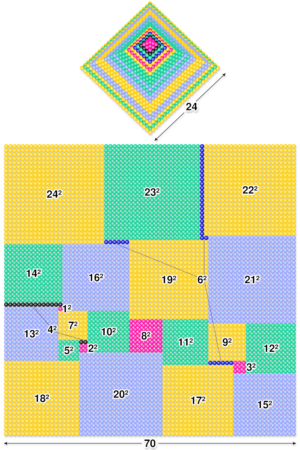Cannonball problem
In the mathematics of figurate numbers, the cannonball problem asks which numbers are both square and square pyramidal. The problem can be stated as: given a square arrangement of cannonballs, for what size squares can these cannonballs also be arranged into a square pyramid. Equivalently, which squares can be represented as the sum of consecutive squares, starting from 1.
Formulation as a Diophantine equation
When cannonballs are stacked within a square frame, the number of balls is a square pyramidal number; Thomas Harriot gave a formula for this number around 1587, answering a question posed to him by Sir Walter Raleigh on their expedition to America.[1] Édouard Lucas formulated the cannonball problem as a Diophantine equation
- [math]\displaystyle{ \sum_{n=1}^{N} n^2 = M^2 }[/math]
or
- [math]\displaystyle{ \frac{1}{6} N(N+1)(2N+1) = \frac{2N^3+3N^2+N}{6} = M^2. }[/math]
Solution
Lucas conjectured that the only solutions are N = 1, M = 1, and N = 24, M = 70, using either 1 or 4900 cannon balls. It was not until 1918 that G. N. Watson found a proof for this fact, using elliptic functions. More recently, elementary proofs have been published.[2][3]
Applications
The solution N = 24, M = 70 can be used for constructing the Leech lattice. The result has relevance to the bosonic string theory in 26 dimensions.[4]
Although it is possible to tile a geometric square with unequal squares, it is not possible to do so with a solution to the cannonball problem. The squares with side lengths from 1 to 24 have areas equal to the square with side length 70, but they cannot be arranged to tile it.
Related problems
A triangular-pyramid version of the Cannon Ball Problem, which is to yield a perfect square from the Nth Tetrahedral number, would have N = 48. That means that the (24 × 2 = ) 48th tetrahedral number equals to (702 × 22 = 1402 = ) 19600. This is comparable with the 24th square pyramid having a total of 702 cannon balls.[5]
Similarly, a pentagonal-pyramid version of the Cannon Ball problem to produce a perfect square, would have N = 8, yielding a total of (14 × 14 = ) 196 cannon balls.[6]
The only numbers that are simultaneously triangular and square pyramidal, are 1, 55, 91, and 208335.[7][8]
There are no numbers (other than the trivial solution 1) that are both tetrahedral and square pyramidal.[8]
See also
- Square triangular number, the numbers that are simultaneously square and triangular
- Close-packing of equal spheres
References
- ↑ David Darling. "Cannonball Problem". The Internet Encyclopedia of Science. http://www.daviddarling.info/encyclopedia/C/Cannonball_Problem.html.
- ↑ Ma, De Gong (1985). "An Elementary Proof of the Solutions to the Diophantine Equation [math]\displaystyle{ 6y^2=x(x+1)(2x+1) }[/math]". Sichuan Daxue Xuebao 4: 107–116.
- ↑ Anglin, W. S. (1990). "The Square Pyramid Puzzle". American Mathematical Monthly 97 (2): 120–124. doi:10.2307/2323911.
- ↑ "week95". Math.ucr.edu. 1996-11-26. http://math.ucr.edu/home/baez/week95.html. Retrieved 2012-01-04.
- ↑ Sloane, N. J. A., ed. "Sequence A000292 (Tetrahedral (or triangular pyramidal) numbers: a(n) = C(n+2,3) = n*(n+1)*(n+2)/6)". OEIS Foundation. https://oeis.org/A000292.
- ↑ Sloane, N. J. A., ed. "Sequence A002411 (Pentagonal pyramidal numbers: a(n) = n^2*(n+1)/2)". OEIS Foundation. https://oeis.org/A002411.
- ↑ Sloane, N. J. A., ed. "Sequence A039596 (Numbers that are simultaneously triangular and square pyramidal)". OEIS Foundation. https://oeis.org/A039596.
- ↑ 8.0 8.1 Weisstein, Eric W.. "Square Pyramidal Number". http://mathworld.wolfram.com/SquarePyramidalNumber.html.
External links
 |



